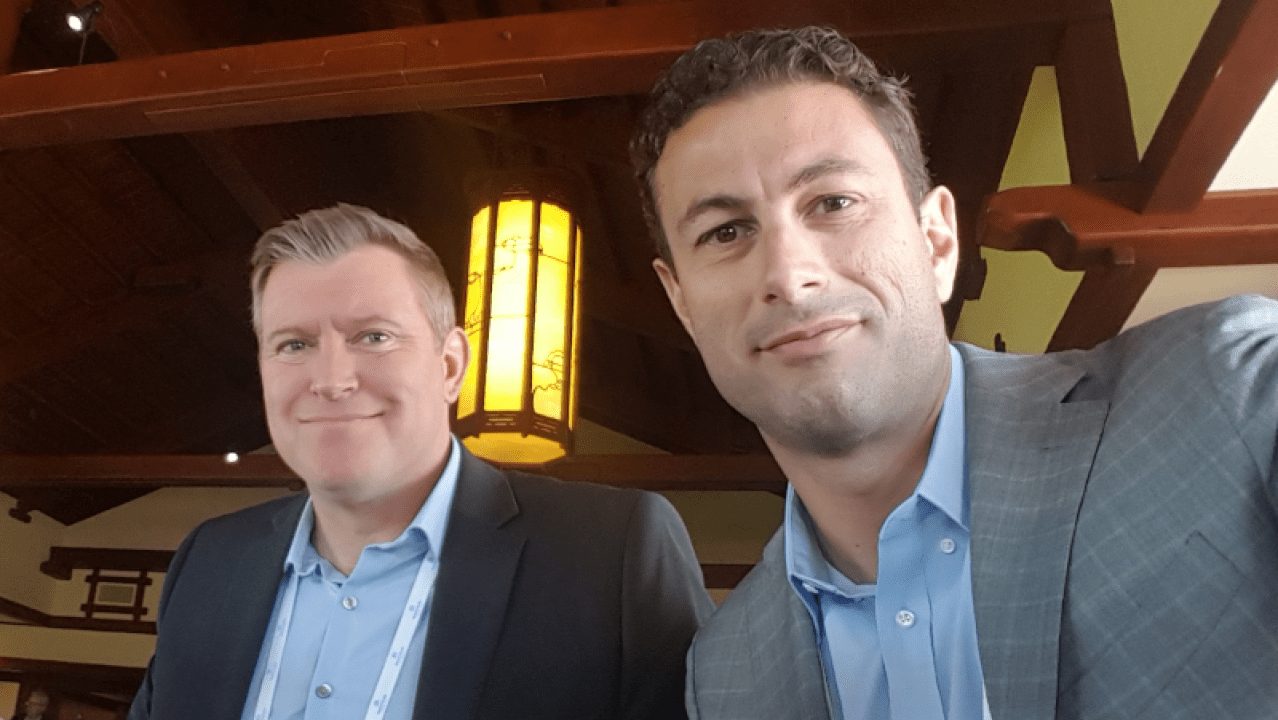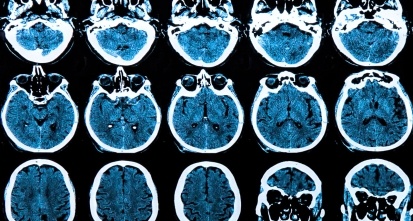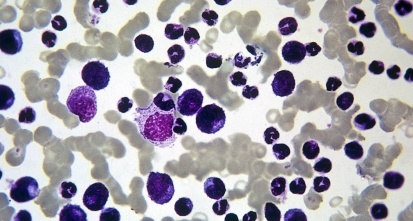Gain new perspectives for faster progress directly to your inbox.

A conversation with Mauro Mileni, PhD. and Chris Roth, PhD. from Abilita Therapeutics
Despite the development of powerful computational tools and wet-lab technologies, finding robust hits continues to be a major challenge for drug discovery teams. To gain more insight into how companies are approaching this and other challenges with filling a successful therapeutic pipeline, the CAS team spoke with Mauro Mileni and Chris Roth of Abilita Therapeutics.
CAS: What inspired you to launch your own company?
Mauro: I started the company because I needed to get out of the cold room! As a graduate student and postdoc, I focused on membrane protein structural biology, using crystallography to understand structure-function relationships. But as anyone with experience working on membrane proteins knows, they can be very difficult to work with. I ended up spending a lot of my time in the cold room trying to get membrane proteins stable enough for crystallographic studies.
What I realized after many years working with them, is that stabilizing membrane proteins is not only essential for crystallography; it also translates into more effective drug discovery, especially for finding hits. The same fundamental obstacles that made membrane proteins so difficult to work with in structural biology could really impact applications where the target protein might be used for drug discovery. I wanted to find a way to leverage the principles of directed evolution to create more stable functional derivatives of target proteins, to make them better for drug discovery, and I turned this idea into Abilita Therapeutics.
Chris: Solving those first crystal structures, the only tool we had in our arsenal was “hunt and peck”. For years, people have worked on enzymes and other proteins to make them more stable, more active in harsh environments, and so on. Back then, with GPCRs, the only option available was to systematically make mutations in the protein and see what happens, then make another change and see what happens. It was an extremely laborious, iterative process, which is why I spent my entire thesis project screening through thousands of mutations to find essentially one position that would confer transformative stability to an adrenergic receptor. This approach was far too inefficient to make a general impact on the field.
The main concept for Abilita was that we could apply directed evolution to membrane proteins and leverage nature to find an optimum solution to the stability challenge, so we have taken a very slow, laborious, and costly process and have replaced this with our evolution system to dramatically speed things up. The fundamental invention was how to create the conditions necessary to drive protein evolution. To do this, we had to make it essential to the survival of the host and then put pressure on that system to evolve for traits that benefit drug discovery.
CAS: What do you see as the biggest challenges in drug discovery?
Chris: You can always get hits, but getting novel, relevant hits is the hard part. The heart of the problem is that the same screening techniques, generally high-throughput, cell-based assays, have already been applied to many of the tough targets of interest, with everybody using very similar approaches. The industry is asking the same question over and over again, just with slightly different parameters, and expecting a novel answer.
Very little in terms of technology has changed—most companies take a brute-force screening approach using massive compound libraries. Cells are treated with these libraries and a biochemical response is screened for, which clearly works, as this has led to the majority of approved drugs to date. However, when it comes to finding novel hits where traditional methods don’t work, the likelihood of finding a relevant hit is slim. Membrane proteins like GPCRs exist in many different conformations, and presenting a conformation linked to a physiological condition during the discovery process can be difficult, if even possible. In fact, we often find that the tougher targets don’t even fold functionally from the start. This isn’t something that can just be screened around.
Mauro: There are a multitude of components on the cell surface that can obfuscate the results of cell-based screens. When doing antibody discovery in complex systems like cells, there are peripheral structures such as other proteins, lipids, and sugars that complicate, or even inhibit, the interaction with the target. This, unfortunately, results in a lot more noise, like false positives, from these screens. By developing assays stripped down to just the big libraries and a target protein, we could potentially circumvent most of these complications.
Another crucial aspect that must be considered is that most membrane proteins maintain an ensemble of conformations. They are flexible by nature, and this flexibility is a major issue when using them for discovery campaigns. What you are actually looking for is not just an interaction of a potential drug with your target, but a specific conformation of that target. A primary characteristic of proteins deemed undruggable is they likely experience many fluid conformations in their native state, which can hinder discovery with traditional cell-based methods.
CAS: This seems like a major limitation, what do you propose as a solution?
Mauro: We actually developed our EMPTM technology as a solution to this problem. We approach drug discovery from the perspective that no target is undruggable. Our technology was designed to take a target of interest and, through directed evolution, to improve the properties of this target, for example, to increase its expression, stability, or homogeneity. We believe that this is achieved by improving protein folding and ultimately restricting or preventing the target from switching among conformations. By locking the membrane protein into a specific disease-associated form and using this as the target for compound screening with protein-based methods, it may be possible to drug any target. Using this approach, we can now find unique hits for targets that many drug discovery teams think are unreachable with current physical screening assays.
Chris: This allows us to do discovery using purified, properly folded, and stabilized target proteins, which is a holy grail in the membrane protein world. Conformational homogeneity and stability are crucial for successful protein-based assays. Whether stabilizing the native conformation or skewing the conformation towards the pharmacology you're looking for, finding mutations that adapt the protein to withstand removal from the cell membrane while maintaining a native conformation is key for discovery.
This opens up a realm of possibilities to turn the toughest target into a rare reagent that makes discovery accessible. We feel that this is just the tip of the iceberg; as the technology improves, so does the spectrum of our capabilities, allowing us to go anywhere with these undruggable targets, or as I call them yet-to-be-drugged targets. It’s a very dynamic approach that enables structure-based studies, the screening of compound libraries, as well as immunization studies to isolate antibodies.
With this method, we can also explore the dynamics of the target-drug interaction. Just like a crystal structure, you need to have the active state structure and the inactive state structures in between to understand the conformational landscape. Especially if you want to discover a biased agonist, a partial agonist, or an inverse agonist. This allows us to find molecules of defined pharmacology interest, rather than just binders.
We're looking to evolve the target towards a specific, and I won't say conformation, but a family of conformations, that resemble the active state or resemble the totally inactive state of our particular membrane protein. Whatever the relevant functional state is for the disease we're after, and the MOA we're after, producing a target that resembles that as much as possible greatly increases the probability of success.
CAS: Do you think this new technology is only applicable to small molecule screening?
Mauro: While it is a very powerful tool for small molecule discovery, we see the most potential in applying it to antibody discovery. Our internal pipeline is primarily focused on developing antibody therapeutics, though we are setting up collaborations with pharma companies to do small molecules as well. This amplifies the potential of our technology of course, and also expands what we can do. We can take advantage of other companies' pipelines, where we do the initial discovery and the drugs are developed in somebody else's lab.
These collaborations also generate capital that helps us push forward our own programs that could use the additional funding. So, we see this as a win-win for both Abilita and our collaborators, we can focus on developing our antibody therapeutics in-house while still having an impact in the small molecule space. We are always open to new partnerships or collaborations with companies that want to use our technology, and we see this as a major opportunity to push the drug discovery field as a whole.
Chris: We feel that improving antibody discovery is one of the most directly impactful uses of our technology. The most beneficial aspect is it opens up a space that has been almost inaccessible to polytopic membrane proteins like GPCRs, ion channels, and transporters. There are only a few approved antibody-based therapeutics targeting GPCRs, with more entering the clinic, but that is the bottleneck that we look to address first.
CAS: Besides the potential for discovery, are there other benefits for developing therapeutic antibodies?
Mauro: With small molecule modalities you often have to take a pill every day, but with antibodies, one shot could remain effective for many months. The difficult diseases we go after are generally pain, cancer, or autoimmune diseases, where the targets can also be orphan GPCRs. These often require long-term treatments, making antibodies more beneficial to the patient. Antibody drugs offer additional advantages, like enhanced selectivity and peripheral restriction. Instead of worrying about dosing and off-target effects when taking a small molecule drug daily, antibodies offer a longer-lasting intervention while limiting the negative impacts on the patient’s well-being.
CAS: What other bottlenecks for drug discovery do you see in the industry?
Chris: There's a big innovation gap. I think this is the number one bottleneck to medicine itself, the same things get done over and over again because they've been proven to work in some instances. There is a lot of might and muscle being thrown around in the drug discovery arena that can stave off the need for innovation. Large companies are really good at putting money behind the problem to push it through to market, even in the face of competition, rather than going after something new where they might fail. That's a major difference for small companies. We're good at pushing the early work and finding new ideas, but taking those forward is difficult.
On the business side, large pharmaceutical companies often prioritize validated targets and approaches based on their probability of success and not on the possibility of opening up new avenues of treating a disease. Due to the risk component, they tend to rely on small companies like us to carry out the discovery and early studies. We can de-risk assets to a point, but that bar is being moved farther and farther down the line as investors are less enthusiastic about overspending on new molecules. This exacerbates the problem as large pharmaceutical companies like to see data from the clinic before they take on a novel mechanism of action in-house.
Unfortunately, for these large pharmaceutical companies the probability of success is often prioritized over innovation due to the massive financial inputs for their projects, leading to an overly conservative strategy. As a small company, we can afford to take on high-risk high-reward projects, so we try to prioritize innovation even with the prospect of failure. This is why we have got to find a way to get small biotech and biopharma companies to meet in the middle with the big players and embrace the earlier work that we can do to push the field as a whole.
Mauro: I've noticed in the antibody space that large pharmaceutical companies are still trying to do DNA and RNA immunization using wild-type sequences. I recently gave a talk to a pharma audience about the challenges of expressing and purifying membrane proteins, with fragmentation and misfolding being the main issues. Current antibody discovery methods require you to take the DNA or the RNA from your target gene and inject them into an animal and hope that something will happen.
Unfortunately, the same observations that I see in my screens, fragmented and misfolded proteins, will most likely occur in the animal system. This is why using the stabilized protein target in the process is a more useful approach. We have identified this as a big problem in antibody discovery, so we are trying to avoid those failures while making our system more streamlined, and focusing on what really works. By stabilizing the conformation of a protein to fish out the antibodies with desired properties, and in combination with large libraries, you get a much better chance to pull out a true hit.
Chris: You need to find new pharmacologies that may be difficult to look for when an assay doesn't exist. When you move into undruggable spaces, not all of it is because the target's tough; often, there is no system in place to properly screen the target. But I think the overarching theme is that you need to find a drug that not only works but one you can push down the pipeline, has desirable properties, and, most importantly, is novel.
With GPCRs, which tend to be on the more difficult end of the spectrum, often the function or endogenous ligand isn't even known, yet its role in the disease is well established. How do you find hits against that? There is no assay. You can't work with the target. There's no knowledge base to even develop a screen. Essentially, it is a non-starter within a big organization because it will just get down-prioritized immediately, and this is a major problem. That's the space that we operate in, where pharma may have down-prioritized a target due to an unacceptable level of difficulty. We are looking to discover those truly novel molecules where others can’t or will not go.
CAS: Do you think AI software like AlphaFold can help overcome these challenges?
Chris: The problem with protein folding predictions is the overall architecture can get pretty close, but it has issues with the important details. For example, which way the residues are aimed or slight changes in the orientation of the helices, it doesn't take much to throw off the relevant details. I think AlphaFold is a great tool to use as a starting point for protein engineering, and I use it all the time because it does a great job of building homology models.
Now, when it comes to de novo prediction of little-known families or novel targets, I don't know how effective it is. I would imagine the performance won't be as good as it is with GPCRs, where the architectures are well-established with hundreds of crystal structures these days. This is why human curation of the biological data is still crucial.
Mauro: A while back, I saw an article saying AlphaFold solved 200 million structures. So, we're done, right? If you want to make pretty pictures for the cover of a paper, that's enough. If you want to do drug discovery, that's different. With docking, for example, you have to start from a model that is very close to the actual structure. You also have to accurately predict all the side chains of the residues, and that’s a different universe. For some things, like engineering, figuring out more or less where a residue sits in the model is actually very useful. If you want to use it for discovery, then I think you need a bit more, especially with membrane proteins.
The other thing is that for soluble proteins like enzymes, there are generally only a couple of residues that switch from one conformation to another. With membrane proteins, you have high flexibility and various conformations; you really have to predict the structure of every conformation. That would become really difficult for AI alone, rather than actually going in with the real thing and screening for the compounds in the right conformations.
CAS: Lastly, if you had a magic wand to change anything about drug discovery, what would you change?
Chris: Streamline the translation from initial thoughts or experiments to more complex models. The biggest problem, especially with novel targets, is the lack of translatability between in vitro efficacy screens to in vivo animal models to something that is efficacious in humans. That's nothing new really, but I think in terms of anything that can speed up the progress of drug discovery and medicine as a whole. The irony is that the more difficult or novel the target, the more inherent risk there will be in translation, and it’s a challenge just to discover the initial tools necessary to validate target biology. This is especially relevant in the orphan GPCR space where the biology is the least understood, but where taking risks is necessary. This is where we believe new innovations can make an outsized impact.
Mauro: I would make it faster and cheaper to get something to market. It takes so many years and so much money to go from a hit to actually getting the drug into the market. The average cost of developing a drug is between one and two billion dollars now. The vast majority of this cost is devoted to working on molecules that don't do anything, or they're not developable. It would be incredibly useful to have a tool earlier in the development process that actually explains or predicts why something works or not in the clinic. This would greatly decrease both the money and time spent on the development of a drug.
Mauro Mileni is the Founder and CEO of Abilita Therapeutics. He established the company with the aim of translating concepts forged from years of working on difficult membrane proteins often called “undruggable”, such as GPCRs and ion channels, into groundbreaking new technologies capable of overcoming fundamental obstacles and making them “druggable”. Mauro had long envisioned an innovative approach that would harness the power of evolution to address inherent challenges associated with the membrane proteins themselves, a technology that can improve their properties and enable discovery for virtually any target. Before founding Abilita, Mauro earned a Ph.D. from the Max Planck Institute of Biophysics, Frankfurt am Main, did postdoctoral work at The Scripps Research Institute, and was a key structural biology scientist at Receptos, Inc.
Chris Roth is the Vice President of Research at Abilita Therapeutics and has been with the company for nine years. Like Mauro, Chris acquired extensive experience in membrane protein engineering, production, and structure determination during his Ph.D. and postdoctoral work at The Scripps Research Institute where he was part of the team that solved some of the first high-resolution GPCR crystal structures and an inventor of key GPCR engineering technologies that continue to be used throughout the field. Chris left Scripps to join Receptos as one of the first members of the scientific team at Receptos and worked with the team to move GPCR structure-based approaches from an academic pursuit to real-world drug discovery.
Abilita Therapeutics is an early drug discovery company whose mission is to create transformative options for future patients by unlocking the full therapeutic potential of membrane protein targets. They are building a pipeline of antibody therapeutics discovered using their proprietary Enabled Membrane Protein (EMP™) technology and partnering with pharmaceutical companies looking to amplify the potential of their EMP platform for drug discovery.



